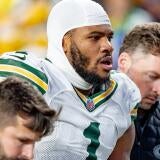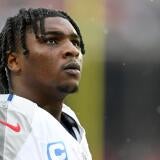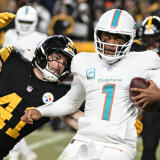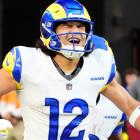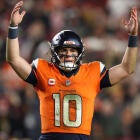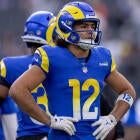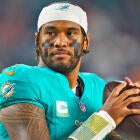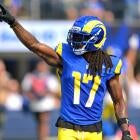2019 NFL Week 3 practice squad power rankings: Pete Carroll poaches a defensive back from a division rival
Former 49ers safety Adrian Colbert could find himself in a niche role for the Seahawks very soon
Pete Carroll, who I refuse to believe is 68 years old, and Seattle Seahawks WWE-belt wearing GM John Schneider made a shrewd practice squad addition this week.
They signed safety Adrian Colbert 12 days after he received an injury settlement from their division rival San Francisco 49ers, who are quietly 2-0. Why's this a big deal? Because Colbert really flashed as a rookie in 2017 and was Kyle Shanahan's starting free safety for the first half of the 2018 campaign before an ankle injury landed him on IR.
Now he wears blue, green, and silver. The Seahawks have the best non-throwback uniforms in the league, by the way.
Colbert boasts a rather impressive pedigree for a practice squad player, for a few reasons. First off, he was a four-star recruit and the No. 11 safety in the 2012 class coming out of high school per 247 Sports' Composite Score. He enrolled at Texas, played there for three seasons and made a minimal impact. He grad transferred to Miami for his redshirt senior year and tallied three pass breakups and a pick in seven games.
His officially unofficial time at the Miami Pro Day was 4.38, and some scouts in attendance clocked him as fast as 4.25. Colbert's blistering time was likely a big reason he was picked by the 49ers in the seventh round of the 2017 Draft. Because of his explosiveness and production as a rookie, Colbert debuts at No. 2 in the Week 3 rankings.
These rankings will be updated throughout the season, as more players move onto practice squads while some get the call up to the 53-man roster. Before I begin, big ups to Robert Davis, last week's No. 1 practice squad player, who literally was elevated to the Redskins' 53-man roster hours after the Week 2 rankings went live.
1. Kyle Sloter, QB, Cardinals
In the preseason, the 6-foot-5, 217-pound former undrafted free agent quarterback from Northern Colorado completed 76.5% of his throws at a hefty 8.7 yards per attempt with four touchdowns and one interception. He flashed plenty of velocity of his throws -- especially at the intermediate levels -- good pocket patience, and impressive throw-on-the-run ability in the Vikings' play-action, bootleg heavy attack. Last preseason, his completion percentage was 73.0, and he threw four touchdowns without a pick.
2. Adrian Colbert, S, Seahawks
As a rookie in 2017, Colbert received a "high-quality" grade of 73.1 from Pro Football Focus on 530 defensive snaps for the 49ers. He broke up five passes and had one interception while making 32 tackles.
3. Vincent Taylor, DT, Bills
After second-year defensive tackle Harrison Phillips went down with a torn ACL in Week 3, it was between Taylor and Kyle Peko to receiver call up from the Bills before their massive home game against the Patriots on Sunday, and the latter was recipient of said call. Despite missing out on a spot on Buffalo's 53-man roster right now, Taylor remains on the team's practice squad.
He was a sixth-round pick of the Dolphins in 2017 out of Oklahoma State, and in his final two years with the Cowboys, he had 12 sacks and 23 tackles for loss. At the combine, the 6-3, 304-pound interior defensive lineman tested solidly across the board with a 40-yard dash, broad jump, and three-cone drill all above the 56th percentile at the position. Taylor made his name as a run defender initially but showcased good hand use and a high motor as a pass rusher as well.
While playing a limited role in Miami in his first two seasons with the team, Taylor was very efficient. He recorded four tackles for loss, two sacks, and 45 total tackles on 185 snaps as a rookie and 204 snaps in 2018. He received "high-quality" grades of 84.1 and 76.3 respectively in 2017 and 2018 from Pro Football Focus.
4. Jeremy Reaves, S, Redskins
Reaves was everywhere for the Redskins in the preseason, and his collegiate career at South Alabama foreshadowed his multi-faceted skills at the safety position. The No. 141 overall prospect on my 2018 Big Board -- and No. 13 safety -- went undrafted after registering at least 85 tackles in each of his final three years with a grand total of eight picks, eight forced fumbles, and 22 pass breakups in those seasons.
Despite a smaller-ish frame and average-at-best athletic ability, Reaves finds the football thanks to high-caliber instincts on the back end, and he's a willing, reliable run defender.
5. Duke Williams, WR, Bills
You may remember Williams from his time as a star wideout at Auburn ... back in 2014. He and Sammie Coates were the primary downfield targets for Nick Marshall. Williams was dismissed from the Tigers football team in 2015 for violating team rules and went undrafted after running 4.72 at the combine at 6-2, and 229 pounds. His agility-drill times were very poor, too.
He then went the CFL route and led the league in receiving yards in 2018. After a strong albeit unspectacular training camp with the Bills, Williams showed out in the preseason with eight catches for 71 yards with two impressive scores in which he was able to showcase his rebounding ability. Williams is the epitome of a big-bodied target who knows how to shield defenders with his body and has strong hands.
6. Marcell Ateman, WR, Raiders
Ateman was picked in the seventh round of the 2018 Draft, and I thought he should've been picked much higher. Ateman was my No. 38 overall prospect and No. 4 wide receiver. While maybe I was a bit too high on him, Ateman averaged nearly 20 yards per reception and finished with over 1,110 yards in his senior season at Oklahoma State in 2017, although that accounted for just 22.8% of the Cowboys' passing offense that year.
At the combine, the 6-4 Ateman didn't test well, running 4.62 in the 40 and finishing with agility-drill times that didn't reach the 41st percentile at the position. He was definitely a "trust the tape" prospect for me, as he was a super-steady ball skills master in college. However, Ateman got the practice squad call up last season and flashed. He had 15 receptions for 154 yards and a touchdown on just 370 snaps. In the 2019 preseason, he had eight receptions for 101 yards. Ateman proved last year he can make an impact in the regular season and be, at the very least, a low-end No. 3 wideout in this league right now.
7. Jason Cabinda, LB, Lions
Cabinda averaged 89 tackles, 5.6 tackles for loss, 3.6 pass breakups and 2.3 sacks over his final three seasons at Penn State. While he didn't run the 40 during the pre-draft process, he didn't appear to be a super-fast linebacker but was always around the football due to quick processing skills and an always humming motor. He displayed refined block-defeating skills with the Nittany Lions and was not a liability in coverage.
After going undrafted last year, my No. 120 overall prospect in 2018 class signed with the Raiders and saw the field late in the season. He didn't dazzle but fared well on the inside, finishing with 21 total tackles and a "high quality" PFF grade of 73.6 on his 164 defensive snaps. In the 2019 preseason, Cabinda missed some tackles, which likely led to his release by the Raiders, but he has the mental ability and polished skills to sift through traffic to be a quality backup at the middle linebacker position.
8. Anthony Johnson, WR, Chargers
Johnson was my No. 61 overall prospect and No. 10 wide receiver in the 2019 class. I loved the completeness of his game at nearly 6-2 and 208 pounds while at Buffalo. He won in traditional chain-mover type ways: shielding with his body, strong hands in tight coverage. He was impressive tracking the football down the field and excelled after the catch in a deceptive way. He accounted for a whopping 39.7% of the Bull's receiving yards as a junior and 32% in an injury-riddled senior campaign. Johnson, who's Jadeveon Clowney's cousin, finds himself on a Chargers team dealing with plenty of injuries of its own, and Mike Williams could miss time.
Per PFF, Johnson had the fifth-best contested-catch percentage among draft-eligible receivers in 2019 and the second-best yards per route run average in 2017 and 2018 combine, behind only first-round pick Marquise Brown. While Johnson didn't have a monstrous preseason, I believe he could be plugged into a part-time role for Los Angeles and contribute in a variety of ways as a rookie.
9. Dillon Mitchell, WR, Vikings
Mitchell was the unquestioned top target for Justin Herbert in 2018. He accounted for a very encouraging 36.7% of Oregon's receiving yards and scored 10 touchdowns. His game is predicated on slippery movements at the line and especially after the catch. Also, Mitchell is fast down the field. He ran 4.46 at the combine and tracks the football well on those long balls. He was my No. 58 overall prospect and No. 9 wideout in the 2019 class.
Mitchell only made one reception for 10 yards in the preseason, which is why he's lower on this list than his pre-draft ranking would indicate. The Vikings seemingly want to ride Dalvin Cook in 2019, but there isn't much depth behind Adam Thielen and Stefon Diggs at receiver on Minnesota roster, meaning the 6-1, 197-pounder has a decent chance to get a call up at some point during the season.
10. Stanley Morgan, WR, Bengals
Morgan was my No. 99 overall prospect in the 2019 class, and my No. 16 wide receiver. In my final Big Board, I wrote this about him: "Morgan has a very well-rounded game and is a running back after the catch. He plays at 100 mph." Per PFF, he led all Big Ten receivers in downfield receiving yards (535) in 2018 and led all draft-eligible Big Ten receivers with plays of 20-plus yards (23), one more than second-round pick Parris Campbell.
At 6-0 and 202 pounds at the combine, the former Nebraska star ran a somewhat disappointing 4.53 in the 40. But all the rest of the on-field drills (vertical, broad jump, three cone, and short shuttle) were very good, as none of his results were below the 73rd percentile at the position. Morgan's statistics improved each year in college, and he finished by accounting for 33.8% of the Huskers' receiving yards. His arrow is still pointing up. He did have two drops in the preseason but reeled in five of eight targets for 63 yards in two games. While Morgan doesn't wow in any way, he's a swift mover, impressive after the catch, deceptively fast down the field, and can go up and high point the football.
Honorable Mention
ANTOINE WESLEY, WR, RAVENS: Wesley was a clear redshirt candidate, simply because of his spindly frame. At the combine, he measured in at just over 6-4 and 206 pounds. At Texas Tech, Wesley was as natural of a hands-catcher as I scouted in this past year's draft class. I'm serious. And with incredibly long 34-inch arms, mitts just under 10 inches, and a 37-inch vertical, Wesley boasts a mammoth catch radius. He had over 1,400 yards and accounted for a solid 33.3% of Texas Tech's receiving yards in 2018.
The former Red Raider had three catches for 60 yards in the preseason, and I view him on a similar track to that of one of Baltimore's fourth-round picks in 2018, Jaleel Scott, a lanky, ball-skills specialist who took advantage of his redshirt year (due to injury) and got stronger heading into Year 2. Scott looked the part in exhibition games this summer, as he lead the Ravens in receiving. Wesley can be that type of matchup-problem wideout down the road.
ELIJAH HOLYFIELD, RB, PANTHERS: Holyfield was a classic "plays faster than he timed" prospect. At Georgia, finally in a full-time role after Nick Chubb and Sony Michel departed to the NFL, his feet were impossibly light, and his vision was outstanding. His contact balance was consistent each week too. That led to him being my No. 2 back in the 2019 class ... before the combine. Holyfield tanked there. At a little over 5-10 and a bulky 217 pounds, he ran 4.78 and had a vertical jump in the 4th percentile at the running back position.
Those figures were the catalyst for him going undrafted, and while he did lose the No. 3 ball-carrier battle to Reggie Bonnafon in the preseason, Holyfield averaged a respectable 4.0 yards per carry on his 20 rushes. More importantly, he finished second only to Bonnafon among Carolina running backs in yards after contact per rush at a hefty 3.25, per Pro Football Focus. Holyfield is a natural runner who sees blocks before they're made, and he has a nice blend of quickness and functional power to be a contributing No. 3 running back in the NFL, although he won't run away from anyone in the open field.


